High Desert Flowering Weeds
Here in the High Desert and in many other places, Corn and Field Gromwell are common weeds found along roadsides and in fields. Both weeds are annual with several stems branching from the base. Their tiny white flowers develop in the leaf axils, bunching together while at the bud stage and in bloom. The most significant difference between both are the hairy leaves of Corn Gromwell on both surfaces. These field weeds are invasive, self-seeding and grow anywhere, in any type of soil.
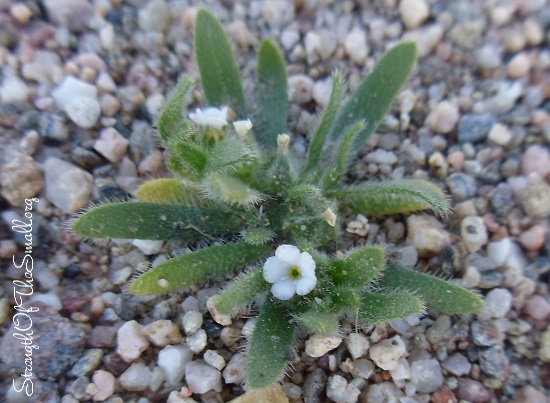

Neatostema Apulum (Yellow Gromwell) is believed to be a rare species facing extinction.

Pineappleweed is an annual self-seeding with flowers exuding a pineapple aroma when crushed. The plants are edible and have been used for medicinal purposes, including for relief of gastrointestinal upset, infected sores, fevers, and postpartum anemia. Click here for more information.
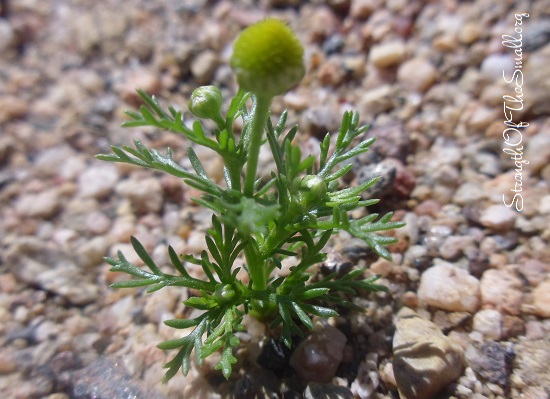
Herb Robert is considered a Noxious Weed and grows as ground cover. It blooms profusely from late Winter to July, after which it dies back from extreme Summer heat. The plant is highly invasive, self-seeding and fast growing. The plant will thrive pretty much anywhere, in any type of soil and under most conditions.
Click here or here to read more about the plant (uses and side effects).
According to Wikipedia, Herb Robert was used as a remedy for toothache and nosebleeds in traditional herbalism. When freshly picked leaves are rubbed on the body the smell is said to repel mosquitoes. The active ingredients are tannins, a bitter compound called geraniin, and essential oils. It was carried to attract good luck, and due to its analogical association with storks, to enhance fertility.

Filaree is a genus of flowering plants with five-petalled flowers in shades of white, pink and purple. It is also a low-growing and common winter annual that strongly resemble Herb Robert.
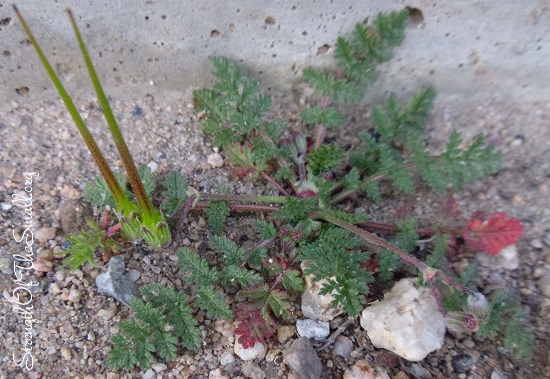
Lotus Strigosus, also known as Strigose Bird’s-foot Trefoil is a low-growing annual often found in sandy soils. The leaves are green, lightly covered in woolly hairs and the tiny yellow flowers are pea-like.
I wouldn’t have noticed how beautiful this little plant is until my Daughter pointed it out to me (and I promised to transplant one in a pot just for her). As far as I was concerned, it was just a nuisance I had to rid my yard of. I have never let the plants grow past the height on the picture, so I can’t comment much on it. But what I know for sure is that they make great ground cover as it is a creeping perennial.
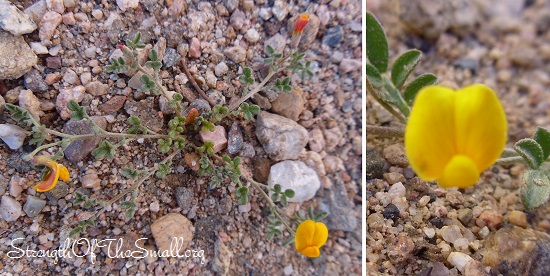
Tropidocarpum Gracile, also known as Dobie Pod is an annual forb native to California and Mexico. The plant is often found on grassland, sandy areas, beaches, woodland, valleys and the Mojave Desert. The flower is yellow with separable petals. The dry slender keel fruit splits open when ripe releasing tiny brown seeds.

Redroot Pigweed is an erect annual herb that germinates from seeds each year, which are produce from late Summer through Fall and germinate from Spring through Summer.
According to Wikipedia, he plant is eaten as a vegetable in different places of the world. Though no species of genus Amaranthus is known to be poisonous, the leaves however, contain oxalic acid and may contain nitrates if grown in nitrate-rich soils, so the water should be discarded after boiling.
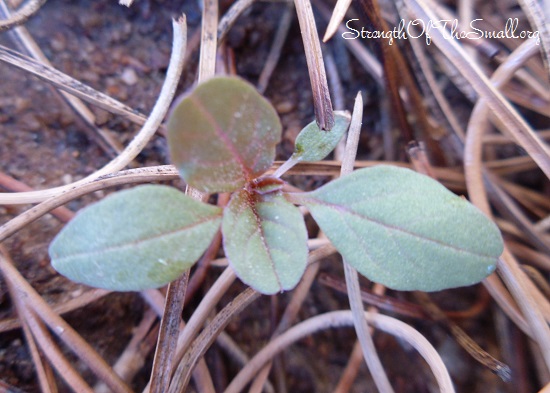
Purslane is considered as an edible plant and a weed.

Eriogonum Trichopes, also known as Little Desert Trumpet, Skeleton Weed and Yellow Trumpetis is an annual herb.
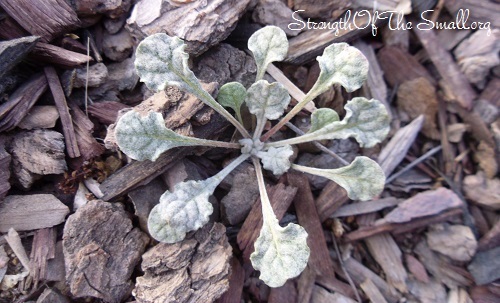
The most dangerous of all is the Tribulus Terrestris also known as Puncture Vine and Tackweed. I know I have a bunch of those around my backyard. Once left to dry out on a field, the nutlets or seeds of this plant can cause serious injuries. The thumbtack-like hard seeds bear sharp spines sharp enough to puncture bicycle tires, lawn mower tires as well as painful injury to bare feet. A couple of years ago, I lost all three of my Tricycle tubes from riding in the backyard.
Tribulus Terrestris is claimed to raise Men Libido. Read the complete article here.
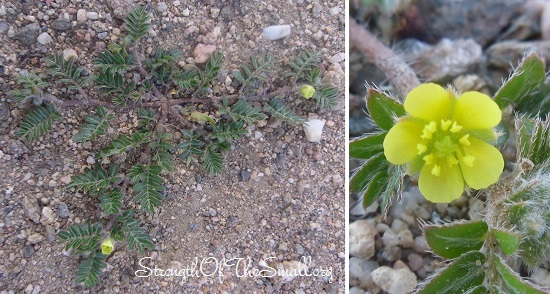

I also found a Lomatium. It is a genus of about 75 species of perennial herbs native to western North America. Many species, including the one below have fern-like leaves with clusters of tiny yellow-green flowers.

Bajada Lupine, is a hairy erect or decumbent annual herb. The plant blooms from March to May with tiny petals which vary from pink to purple. The plant can be found on grassland, sandy areas and desert areas.

Contorted Suncup also known as Sandysoil Suncup is a slender hairy stemmed annual herb found on grassland, sandy areas as well as the Mojave Desert.
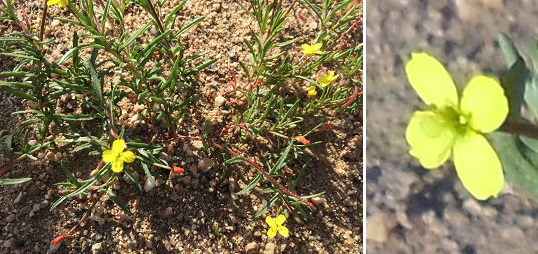
Chamaesyce Polycarpa, also know as Smallseed Sandmat is a species of Spurge. It is a perennial herb native to the southwestern United States and northern Mexico which can be found in the deserts and sandy areas.
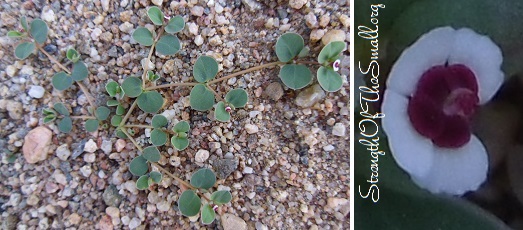
Baileya Pleniradiata also known as Woolly Desert Marigold, Desertmarigold Baileya can be annual, biennial or short-lived perennial and is from the sun flower family.
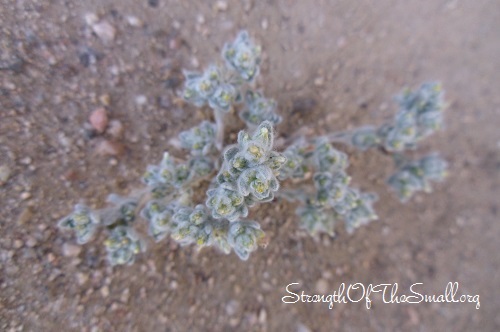
Creeping Woodsorrel is a low-growing, spreading herbaceous plant with a narrow, creeping stem that readily roots at the nodes. The trifoliate leaves are subdivided into three rounded leaflets and resemble a clover in shape. The five yellow petals flowers are present almost year-round. The fruit is a narrow, green cylindrical capsule similar to pods. Click here for more information.
According to Wikipedia, the leaves of wood sorrel are quite edible, with a tangy taste of lemons. A drink can be made by infusing the leaves in hot water for about 10 minutes, sweetening and then chilling. The entire plant is rich in vitamin C. Any wood sorrel is safe in low dosages, but if eaten in large quantities over a length of time can inhibit calcium absorption by the body.

This year I have noticed the presence of an unknown plant, similar to Tortula Ruralis also known as Star Moss and Twisted Moss.
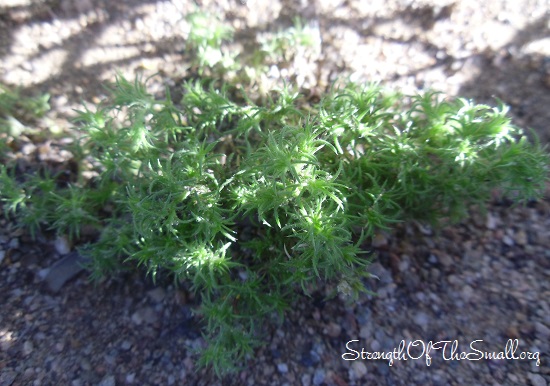
Malva Neglecta also know as Common Mallow, Buttonweed, Cheeseplant, Cheeseweed, Dwarf Mallow and Roundleaf Mallow. The plant is said to have a range of medicinal and food uses. The leaves, stems, fruits and seeds are edible. The plant is used to heal and sooth sore throats, inflammation, sores and swellings, hemorrhoids; to treat dandruff, melancholy, common couch, stomach ache, diarrhea, and so much more.
Click here for additional information.

False garlic also know as false onion weed, is native to South America and produces many seeds and underground bulbils. It’s highly invasise and difficult to control. It is best to dig the plant out than pull as pulling facilitates the bulbs to split and multiply.

Sisymbrium Irio, also known as London Rocket, Tumble Mustard and Rocket Mustard is an annual herb. The leaves, flowers and seeds are all edible.

Caulanthus lasiophyllus, also known as California Mustard and Slenderpod Jewelflower .

The unknown weed below is possibly Erigeron Aphanactis, a biennial herb that is native to the western United States. It is a species of flowering plant in the daisy family, curved leaves and golden yellow flowers.

Young Tumbleweed.

Plantago Lanceolata, also known as Ribwort Plantain and Narrow Leaf Plantain; is a rosette-forming perennial herb with silky leafless hairy flower stems. The leaves and seeds are edible. The leaves are bitter and the bud on the flower stem tastes like mushroom.
The leaves can be collected for medicinal use (mild antibiotic, antihistamine, analgesic, antifungal and antioxidant); and the flowers can be collected after they have turned brown to make a mushroom stock.

Chondrilla Juncea, also known as Rush Skeletonweed, Gum Succory, Devil’s Grass, Hogbite and Nakedweed is a perennial herb in the daisy family. The plant is invasive and can be propagated vegetatively and by seeds.
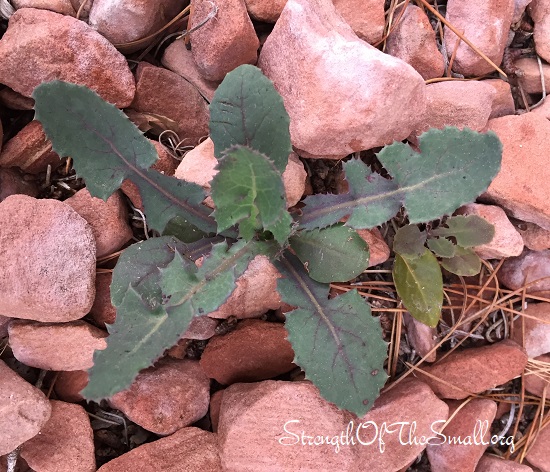
Flixweed, also known as Descurainia Sophia, herb-Sophia and tansy mustard and it reproduces by seeds. It is said that it was once given to patients suffering from dysentery and called by ancient herbalists Sophia Chirurgorum, “The Wisdom of Surgeons” (source).
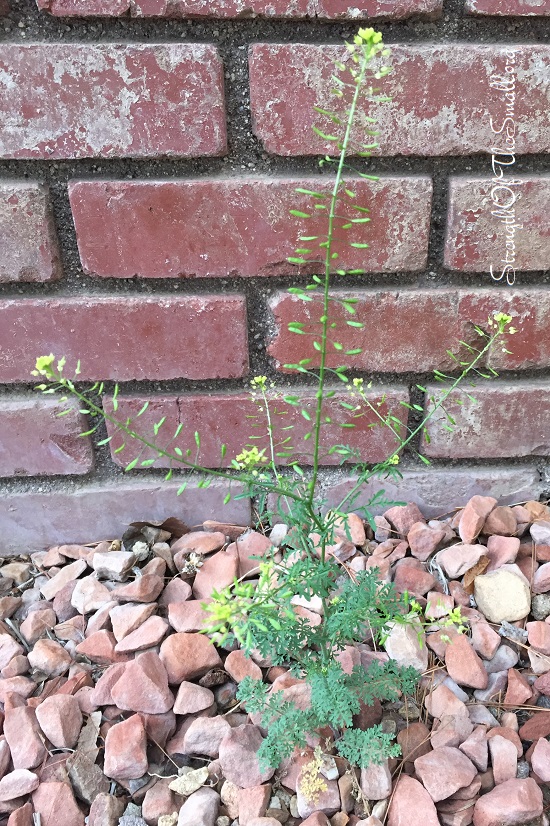
Brassica Oleracea, also known as Wild Cabbage and is native to coastal southern and western Europe.
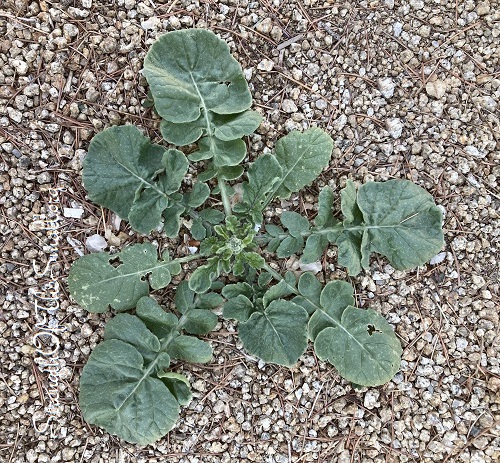
Arenaria Serpyllifolia, also known as Thyme-leaf Sandwort and Thyme-leaved Sandwort, is a tiny annual or biennial flowering plant in the pink and carnation family Caryophyllaceae that is native to Europe and Asia.

Unknown weed below.

Sphagnum Capillifolium, also known as Red Bogmoss or Small Red Peat Moss, is a species of peat moss. They form tight and carpet-like mounds.

Taraxacum Officinale, also known as Dandelion, Blowball, Cankerwort, Dandelion Herb, Dent-de-Lion is a perennial and a member of the sunflower family. All parts of the plant are edible. Dandelion is said to be highly nutritious (providing iron, calcium, magnesium and potassium), is full of full of potent antioxidants, can help with constipation, weight loss, reduce inflammation, lower cholesterol, blood pressure, control blood sugar and so much more. Click here for more uses and benefits.
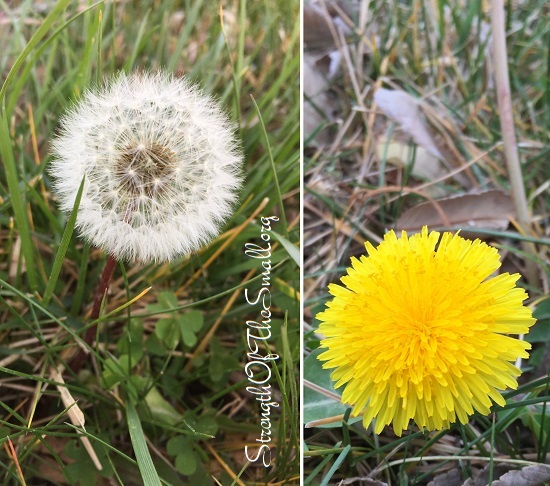
Cistanthe Umbellata, also known as Mount Hood pussypaws is native to western North America. It is a creeping perennial herb forming generally two or more basal rosettes of thick, spoon-shaped leaves each a few centimeters long.

Cheatgrass also known as Downy brome is a Winter annual, highly invasive and a fire hazard when dry.

Distichlis Spicata, also known as Saltgrass, Coastal Salt Grass, Inland Saltgrass, and Desert Saltgrass, is a perennial grasslike herb that is native to California, and also found elsewhere in North and South America, where it is widespread.

Poa Annua, also known as Annual Meadow Grass, Annual Bluegrass, and Poa, is a widespread low-growing grassy weed in temperate climates.

Digitaria, also known as Crabgrass, Finger-grass, is a genus of plants that includes annual and perennial types of grass.

Erigeron Bonariensis, also known as Hairy Fleabane, Flax-leaf Fleabane, Wavy-leaf Fleabane, is a Summer annual or biennial weed in the Asteraceae (daisy) family. The plant is common across the southern United States with leaves covered in soft hair. Flowers bloom from June through September.

Senecio Jacobaea, also known as Ragwort, Common Ragwort, Stinking Willie, Tansy Ragwort, Benweed. It is poisonous to livestock and the daisy-like yellow flowers attract bees, flies, moths and butterflies.

Gnaphalium Uliginosum, also known as Marsh Cudweed, is an annual plant found on damp, disturbed ground and tracks. Flowers are tiny, brown to yellowish, and look like buds.

Spergularia Marina, also known as Salt Sandspurry and Lesser sea-spurrey.

Euphorbia Hypericifolia, also known as Chamaesyce Hypericifolia, Graceful Spurge, Baby’s breath Euphorbia, Graceful Sandmat, Large Spotted Spurge, is a perennial branched herb native to tropical Americas. It can grow up to 2 feet in height, and contains a milky sap which irritate the skin and the eyes.

Common Tumbleweed, also known as Amaranthus Albus, Tumble Pigweed, Prostrate Pigweed, Pigweed Amaranth, White Amaranth, White Pigweed, Stiff Tumbleweed, Rolypoly. If left to dry out, the plant forms tumbleweeds after dying.
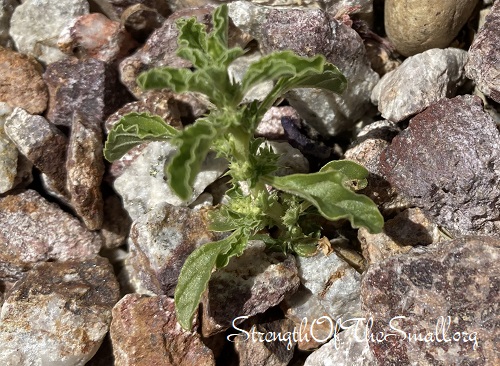
Euphorbia Peplus, also known as Cancer Weed, Petty Spurge, Radium Weed, Milkweed, is an annual small upright plant growing to about a foot high. The sap is poisonous. Skin and eye contact with sap can cause intense pain, blistering, and severe swelling. Ingestion may result in severe vomiting and diarrhoea.
One interesting fact about this plant is that components of its sap are being studied for the treatment of skin cancer, leukemia, warts and sunspots. More information here.

Artemisia Frigida, also known as Fringed Sage.

Veronica Arvensis, also known as corn speedwell, rock speedwell, common speedwell, field speedwell or wall speedwell.

Chaenactis Glabriuscula, also known as Common Yellow Chaenactis and Yellow Pincushion, is a low-growing annual with yellow flowers native to California.

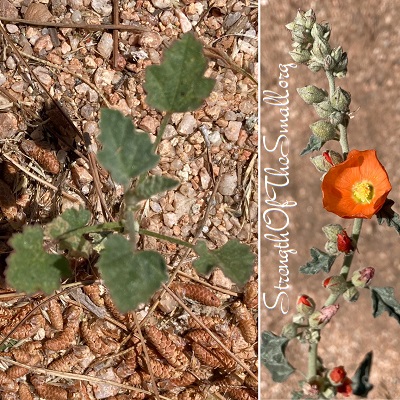
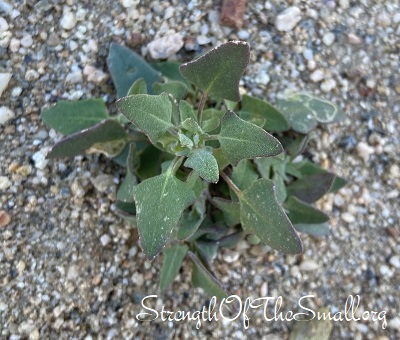

Unfortunately for those of us living in the High Desert there’s no way to completely eradicate weeds as the seeds remain viable for so many years. The best way to rid the weeds from the yard is to pull them out as soon as we see them and before they begin seeding. Click here to read about Our Half-acre Weeding Tips.
Happy Gardening and Weeding!
